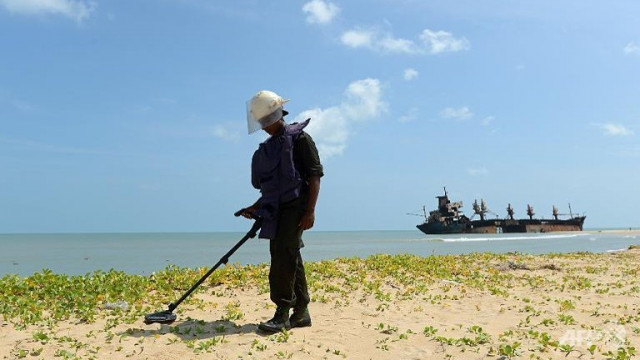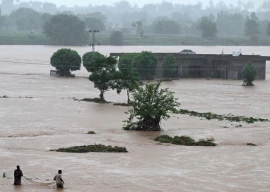
Nobel-prize winning group International Campaign to Ban Landmines (ICBL) in its report on Wednesday, “Landmine Monitor 2014”, identified 11 states namely China, Cuba, India, Iran, Myanmar, North Korea, Pakistan, Russia, Singapore, South Korea, and Vietnam as potential producers of anti-personnel mines.
The report said that although most of these countries are not actively producing mines but they reserve the right to do so. Of these, Pakistan, India, Myanmar, and South Korea still believed to be manufacturing the mines.
According to the estimates of the monitoring body, out of the 35 states who are not party to the Mine Ban Treaty, as many as 31 are stockpiling the weapon. It stated that Pakistan has the second largest stockpile of mines with an estimated six million anti-personnel landmines, behind Russia which has a staggering 26.5 million mines.
India, Pakistan's arch rival, is third on the list with an estimated 4-5 million anti-personnel landmines.
Mines being used by terrorists
The report also noted that non state armed groups in Pakistan, Afghanistan, Colombia, Myanmar, and Tunisia produce antipersonnel mines, mostly in the form of victim-activated IEDs. In July 2014, the Pakistani Army claimed seized a landmine factory in North Waziristan during on going operation against terrorists.
The report recognises that at least nine states, who are not party to the Mine Ban Treaty (including six landmine producing states) Pakistan, India, China, Israel, Kazakhstan, Russia, Singapore, South Korea, and the US have enacted formal moratoriums on the export of anti-personnel mines.
Landmine casualties at 15-year low
Despite the production and stock piles of landmines, global efforts are bearing fruit. Campaigners noted on Wednesday that the number of victims injured by the deadly weapons have fallen to the lowest level in 14 years, with just 3,308 people injured or killed last year by landmines or unexploded ordnance left over from different conflicts -- 25 per cent fewer than in 2012.
In 2013 there was an average of nine victims a day, compared to 25 daily when the Landmine Monitor first started recording casualty rates in 1999. The vast majority of the victim, some 79 per cent, were civilians.
In another measure of success in the fight against the scourge, nearly all use and production of the deadly weapons has ceased around the world.
"While far too many people are still losing their lives and limbs to landmines, new casualties are at their lowest level ever recorded - possibly the best measure of how successful the Mine Ban Treaty has been," said Megan Burke, casualties and victim assistance editor of Landmine Monitor.
"But we can't forget that there are hundreds of thousands of landmine survivors waiting for their needs to be met and their rights to be fulfilled."
Ukraine a lingering concern
While none of the 162 signatories to the Mine Ban Treaty had broken their pledge not to use landmines last year, there are lingering concerns about the crisis in Ukraine.
The group said it remained unclear whether landmines have been laid in the bloody conflict between Kiev and pro-Russian rebels.
"Stocks of anti-personnel mines are present in the ongoing conflict in Ukraine between government forces and Russian-backed separatists," the Landmine Monitor noted.
But it stressed "it is not yet possible to determine whether antipersonnel mines have been used. Ukraine is a state party to the treaty."
"Any use in Ukraine must be halted and fully investigated," insisted Mark Hiznay, senior researcher at Human Rights Watch.
Campaigners also called on Yemen to do more to hold accountable those who laid anti-personnel mines in the Gulf country in 2011 -- the only time a state signatory to the ban has violated the treaty.
But the campaign hailed as "a victory for global recognition of the treaty" this year's pledge by the United States to step up the destruction of its stockpile of some three million mines and to ban US use of anti-personnel mines except on the Korean peninsula.
More than 48 million stockpiled landmines have been destroyed since 1999, and only six signatory countries have failed to complete the destruction of their stocks.
Ukraine, along with Greece and Belarus, remain in violation of the treaty as they have not got rid of such weapons within four years of signing the pact.
Funding for mine clearance shrinking
However, in a negative side-effect of the campaign's success, global funding for mine clearance activities is shrinking even as campaigners strive to meet the goal of a mine-free world by 2025.
"Sustained levels of international funding remains vital as mine-impacted countries continue striving to clear their last minefields and to assist landmine victims," said Landmine Monitor editor Jeff Abramson.


















COMMENTS
Comments are moderated and generally will be posted if they are on-topic and not abusive.
For more information, please see our Comments FAQ